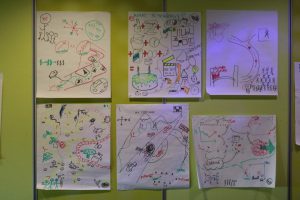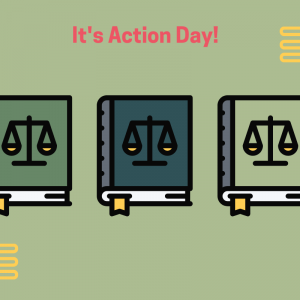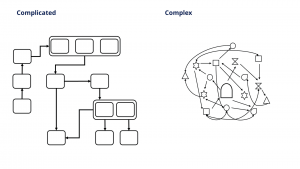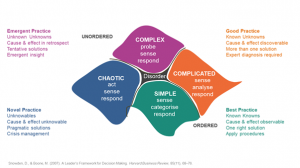4 Rich Pictures and The Cynefin Decision Framework
Rich Pictures and The Cynefin Decision Framework
Rich Pictures

Creating a new product or service, introducing a new production methodology, changing culture, creating new ways of working, addressing debilitting problems and challenges, and dealing with complexity, within organisations – requires a holistic, broad perspective. It is very easy to take a local view of what is going on in problem situations during ongoing cycles of organisational change, and to seek to positively influence what is going on. The situation is usually more than just one issue.
There is usually an interrelationship between multiple ideas, events, perspectives, systems, and so on. A very simple yet rich way of understanding the bigger picture is to draw one. ‘Rich pictures’ are useful when lots of different people are involved, all of whom have different ideas of what the problem is and how to improve the situation. They encourage a systemic and cultural view of the problem situation that takes account of interaction effects between different elements of the system – including people! Healthy connections lead to healthy systems. In human systems, the connection points are mostly the conversations that people have with each other.
Here is a short video of how to use the Rich Picture Technique.
Transcript: Cynefin Framework

Now, this might seem a little patronising or rude, but please watch the video again. Here is the link, or go to the YouTube location above. https://youtu.be/N7oz366X0-8
If you prefer, here is a link to the transcript.
Consider where in the decision framework the set of decisions you need to make, should fit. Consider the likely mindset of the organisations that would potentially be making these long term strategic decisions. Ponder this for a moment.
As you watch the video, listen carefully for the nuances about each space, and be careful about the ‘cliff space’ between Simple and Chaotic. Also please have the reflection questions below in mind as you watch.
Consider your observations and reactions in the context of your current, and perhaps, past situations of decisions making, actions and outcomes. The image below summarises the emergent practices for each quadrant.
Reflection
- Consider your observations and reactions in the context of your current, and perhaps, past situations of decisions making, actions and outcomes.
- How does the framework add to your understanding of how you, your teams and your organisation overall see and make decisions?
- How might you use this complexity decision framework in your own work? In your project thinking or as you approach the opportunity or challenge?
- Think about your own view of the world. What is your default approach to issues and decision situations?
- Think about how you might share with your immediate team your insights and preferences. How might you deal with these in your work context? What impact will your preferences
and those of others, have on the outcomes?

As we wrap up this section, we are reminded that the Cynefin Framework by David Snowden suggests that by addressing issues from the place of complexity thinking, we not only have a way to work but it also gives us a divergent way of thinking. This is based on the idea that the more input into our thinking and decisions models, the more possibilities and opportunities we can explore.
To sum up, Snowden says The Cynefin Framework “gives us a very easy way of deciding how to work but it (also) gives us a divergent (way of thinking) – we sometimes call this requisite applicability. It basically says dependent on which space you’re in, you should think differently, should analyze differently, rather than one-size-fits-all which has been a tradition of management theory”.2
Here is a final word that might help you put this lesson in context and get us ready for the next lesson. The famous American General Stanley McChrystal discusses complicated and complex in detail. He represents the differences in this way:

General McChrystal says that complexity occurs when the number of interactions between components increases dramatically. His wrap-up statement is that the world has become in many ways less predictable despite technology and data-gathering and mining advances.
References
- Snowden, D. J., & Boone, M. E. (2007). A leader’s framework for decision making. Harvard business review, 85(11), 68.
- McChrystal, S. C., Tantum; Silverman, David; Fussel, Chris. (2015). Team of Teams: New Rules of Engagement for a Complex World. Portfolio Penguin.

An interior scene of the Whitehouse, 2020.


